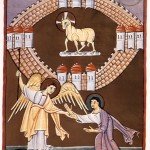I have been sharing thoughts about the last book in the New Testament, namely Revelation or the Apocalypse. The author names his location as the island of Patmos and so he is often called John of Patmos. There is a tradition which says that John the Evangelist retired to or was exiled to Patmos.
From Revelation itself we learn a bit about him. Because it is addressed to Christian communities in seven cities of Asia Minor, most scholars surmise that he was known to them and was probably one of many itinerant teachers or prophets who went throughout the area. He was steeped in the Jewish Bible, the Old Testament. In fact two-thirds of his 404 verses allude to it. His Greek suggests that his native language was Aramaic, which has led to speculation that he grew up in the Jewish homeland as a Palestinian Jew and then traveled to Asia Minor as a Christian missionary, perhaps after the destruction of the temple and Jerusalem in the year 70.
 Finally, he was a religious ecstatic. He had visions. In the first chapter he describes a vision in which one like the Son of Man – the risen Christ – calls and commissions him: Write what you have seen, what is, and what is to take place. Most of the rest of the document, chapters 4—22, is a series of visions he actually had, literary creations or a combination of the two is impossible to discern. What John wrote is an apocalypse. Indeed, the document is commonly known among Catholics as “The Apocalypse”. Originally a Greek word, it means an unveiling, disclosure, revelation. In Judaism Apocalypses were, in the centuries before and after Jesus, fairly common. They were sometimes revelations of the other world, the heavenly world, and sometimes both. This book combines both. Jewish apocalypses come out of a time of oppression and real suffering inflicted by the powers that rule this world and contrast the present evil age with a future blessed age that will come soon through a very dramatic intervention by God.
Finally, he was a religious ecstatic. He had visions. In the first chapter he describes a vision in which one like the Son of Man – the risen Christ – calls and commissions him: Write what you have seen, what is, and what is to take place. Most of the rest of the document, chapters 4—22, is a series of visions he actually had, literary creations or a combination of the two is impossible to discern. What John wrote is an apocalypse. Indeed, the document is commonly known among Catholics as “The Apocalypse”. Originally a Greek word, it means an unveiling, disclosure, revelation. In Judaism Apocalypses were, in the centuries before and after Jesus, fairly common. They were sometimes revelations of the other world, the heavenly world, and sometimes both. This book combines both. Jewish apocalypses come out of a time of oppression and real suffering inflicted by the powers that rule this world and contrast the present evil age with a future blessed age that will come soon through a very dramatic intervention by God.
Like that of other apocalypses, the language of Revelation is highly symbolic. Some numbers are symbolic, especially seven. It appears sixty times and also structures major portions of the document which I will share with you in the next installment of this article. Pick up Revelation and begin reading it.
